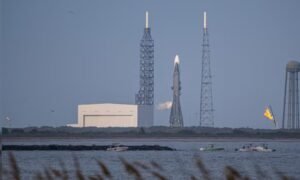Origin of the moon : Scientists propose new theory denying ‘collision theory’
Published: 13 November 2024, 7:28:38

Scientists have been grappling with the mystery of moon’s origin for hundreds of years. The mystery partly solved in 1980s as experts then discovered that the lunar satellite was formed as the aftermath of an explosive impact with the Proto-planet Theia early in Earth’s history.
But a recent study came up with another jaw-dropping theory on moon’s origin, denying the most popular “collision theory”.
A group of Penn State University researchers led by Professor Darren Williams said, “The Earth might have neatly nabbed the moon as it drifted by in a process called binary-exchange capture.”
According to the theory, the moon started life as one part of a “terrestrial planet” and when the pair passed within Earth’s pull, the moon was snagged into orbit while the second body was catapulted out into space.
“No one knows how the moon was formed,” said Professor Williams, adding, “For the last four decades, we have had one possibility for how it got there. Now, we have two.”
Williams and his co-author pointed out that, if the moon were formed from a ring of debris slowly condensing into a sphere, we should expect to find it orbiting above the equator. However, the moon’s orbit is actually tilted onto a totally different plane about seven degrees away from the equatorial plane.
To find an alternative explanation for why this might be the case, the researchers looked at a phenomenon called “binary-exchange capture”.
The explanation suggests that Earth might have ripped one of a pair of passing rocky bodies and made it into its satellite.
In support of this idea, Williams points to the example of Triton, Neptune’s largest moon. Current theories suggest that Triton was pulled into Neptune from the Kuiper Belt.
Just like moon, Triton orbits at a significantly tilted angle, leaning 67 degrees away from the planet’s equator. According to mathematical models, it is quite plausible that the same thing could have happened to our moon.
In the paper published in The Planetary Science Journal, the researchers calculated that Earth could have captured an object between one and 10 percent of its total mass. At just 1.2 per cent of the Earth’s mass, the moon falls comfortably within this range.
The only caveat is that the planetary binary would have had to have passed within just 80,000 miles (128,750km) of Earth at a speed below 6,700 miles per hour (10,800km). While that might seem incredibly fast, in the scale of the solar system that is the equivalent of a leisurely stroll.
The problem is that, even at these sedate speeds, when it first arrived; the moon’s orbit would have been massively elliptical much like that of a comet around the sun.
However, the researchers also show how this orbit would have evolved under the influence of tidal forces.
As the moon races around the Earth, the tides would have slightly lagged behind its orbit, exerting a gravitational pull which would have slowly tamed its wild orbit.
Over thousands of years, that constant tug would have made the orbit more regular and circular until it settled into the close orbit it currently has.
“Today, the Earth tide is ahead of the Moon, high tide accelerates the orbit,” said Williams, adding, “It gives it a pulse, a little bit of boost. Over time, the Moon drifts a bit farther away.”
Now the moon is so far out that both the Sun and Earth pull on it; leading it to drift about 3cm further away every year.
This theory has some key advantages in that it explains why the moon’s orbit is so tilted and accounts for the presence of certain chemical isotopes found on the moon and not on Earth.
The theory would be hard to prove and rely on several “implausible events” happening at once, researchers said.
However, Professor Williams maintains that binary-exchange capture is a viable alternative to the standard collision theory and one that merits further consideration.
The researchers argue that planetary binaries may have been more common in the early solar system and could have plausibly gone on to create the moon.
“This opens a treasure trove of new questions and opportunities for further study,” the Professor furthered.





